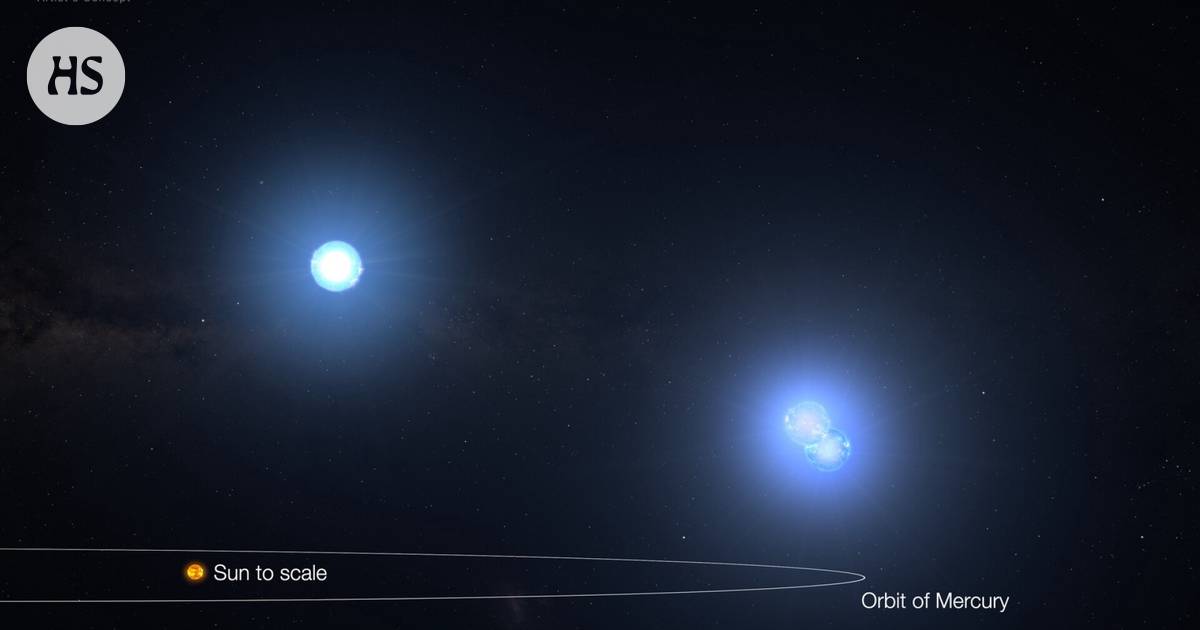The summary is made by artificial intelligence and checked by a human.
Three stars orbit each other in record close proximity in the constellation of the Cygnus.
Two of these orbit each other in three days, the third orbits them in 25 days.
The star trio would fit inside the orbit of the planet Mercury. All stars are more massive than our own Sun.
The discovery was made with the cooperation of NASA’s Tess research satellite, learning artificial intelligence and astronomy enthusiasts.
Star dancing with the stars
In the found dance of three stars, the closeness of the stars and the tempo is close and fast. Astronomers have never observed such closeness of stars before.
Astronomers call the phenomenon with the dance term do-si-do. In this one twist of the American square dance, you can see the dancers circling each other closely in the same way.
Space in the dance, the two stars first revolve around each other in less than two Earth days.
In addition, a third star further away orbits this duo in 25 days.
Everything takes place in an astronomically very tight space. The participants would fit inside the orbit of the planet Mercury if the stars were placed in our own solar system.
Mercury orbits the Sun at an average distance of 58 million kilometers.
Every out of three stars is more massive than our Sun. They are six to eight times as large as our nearest star.
Triples are a part Swan constellation. The catalog name of the constellation is TIC 290061484.
Before the discovery, many groups of three stars had of course been found in space. The most concise of them was called Lambda Taurus.
Its most distant star orbited two other stars in one revolution in 33 days. Lambda Tauri was found already in 1956, i.e. 68 years ago.
From the star trio said the US space agency Nasa and science journal The Astrophysical Journal.
Trio was found NASA’s Tess research satellite through. A group of astronomy enthusiasts also helped with the discovery.
Triples are a part Swan constellation. The catalog name of the constellation is TIC 290061484.
“These are rarely found,” says the retired MIT University astronomer in a NASA announcement Saul Rappaport on the website of the university’s physics department.
“However, they are much more common than the number of Finds indicates.”
Nasa sent the research satellite Tess into space in the spring of 2018. Its main mission was to search for new exoplanets. Hundreds of them have already found it. There are hundreds of candidates on the list yet to be confirmed.
An exoplanet can be found when it passes in front of its parent star as seen from a satellite. Then the luminosity of the star varies, and the size of the exoplanet can be deduced from it.
Now the unusual trio found was seen in the “flashing lights” of the star group. The star group is usually seen as a blob in a telescope.
But when the stars of the trio cross each other’s orbits, different types of eclipses occur. They appear in the telescope as a flicker. You can find them in their shops animated On the NASA website.
Many such eclipse patterns were first discovered by astronomy enthusiasts. If the discovery is promising, valuable equipment will also be directed to the target. In this discovery, data was also collected with the help of learning artificial intelligence.
Respective the star’s own gravity does not disturb the other two stars too much. Therefore, the triplet orbitals do not mix.
When the star trio gets old enough, however, gravity eventually pulls them together. Before long, this one big star will explode as a supernova.
What is left is a neutron star. Such a star is one of the densest objects in space. This will happen in maybe 20-40 million years.
Yet it is not known whether there are planets orbiting the stars. However, they would have to orbit quite far from the stars. Close to the stars, planetary destruction would be likely.
More than half of the stars in our home galaxy, the Milky Way, have one or more companions.

https://www.salvagedata.com/services/data-recovery/pc-computer/
https://www.salvagedata.com/services/data-recovery/on-site/
https://www.salvagedata.com/services/data-recovery/on-site
https://www.salvagedata.com/services/data-recovery/nas/
https://www.salvagedata.com/services/data-recovery/mobile/iphone/
https://www.salvagedata.com/services/data-recovery/mobile/android/
https://www.salvagedata.com/services/data-recovery/mobile/
https://www.salvagedata.com/services/data-recovery/memory-card/
https://www.salvagedata.com/services/data-recovery/memory-card-recovery/
https://www.salvagedata.com/services/data-recovery/laptop-notebook/
https://www.salvagedata.com/services/data-recovery/hard-drive/
https://www.salvagedata.com/services/data-recovery/external-drive/
https://www.salvagedata.com/services/data-recovery/external-drive-recovery/
https://www.salvagedata.com/services/data-recovery/encrypted-data-recovery/
https://www.salvagedata.com/services/data-recovery/emergency/
https://www.salvagedata.com/services/data-recovery/emergency-data/
https://www.salvagedata.com/services/data-recovery/emergency
https://www.salvagedata.com/services/data-recovery/database/
https://www.salvagedata.com/services/data-recovery/database-recovery/
https://www.salvagedata.com/services/data-recovery/database-application-recovery/
https://www.salvagedata.com/services/data-recovery/cloud/
https://www.salvagedata.com/services/data-recovery/cctv/
https://www.salvagedata.com/services/data-recovery/backup/
https://www.salvagedata.com/services/data-recovery/apple-mac-and-macbook/
https://www.salvagedata.com/services/data-recovery/
https://www.salvagedata.com/services/
https://www.salvagedata.com/service-options/
https://www.salvagedata.com/server-data-recovery/
https://www.salvagedata.com/server-crashes-how-to-fix/
https://www.salvagedata.com/security-researchers-detect-new-bladabindi-variant/